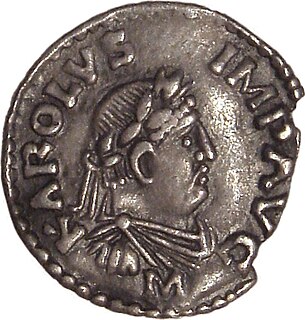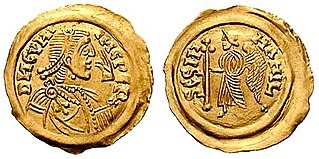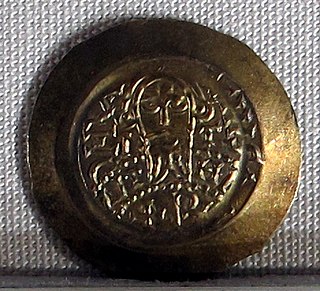 W
WThe Kings of the Lombards or reges Langobardorum were the monarchs of the Lombard people from the early 6th century until the Lombardic identity became lost in the 9th and 10th centuries. After 568, the Lombard kings sometimes styled themselves Kings of Italy. After 774, they were not Lombards, but Franks. From the 12th century, the votive crown and reliquary known as the Iron Crown retrospectively became a symbol of their rule, though it was never used by Lombard kings.
 W
WAdalgis or Adelchis was an associate king of the Lombards from August 759, reigning with his father, Desiderius, until their deposition in June 774. His mother was Ansa. He is also remembered today as the hero of the play Adelchi (1822) by Alessandro Manzoni.
 W
WAgilulf, called the Thuringian and nicknamed Ago, was a duke of Turin and king of the Lombards from 591 until his death.
 W
WAistulf was the Duke of Friuli from 744, King of the Lombards from 749, and Duke of Spoleto from 751. His reign was characterized by ruthless and ambitious efforts to conquer Roman territory to the extent that in the Liber Pontificalis, he is described as a "shameless" Lombard given to "pernicious savagery" and cruelty.
 W
WAlboin was king of the Lombards from about 560 until 572. During his reign the Lombards ended their migrations by settling in Italy, the northern part of which Alboin conquered between 569 and 572. He had a lasting effect on Italy and the Pannonian Basin; in the former his invasion marked the beginning of centuries of Lombard rule, and in the latter his defeat of the Gepids and his departure from Pannonia ended the dominance there of the Germanic peoples.
 W
WAripert I was king of the Lombards (653–661) in Italy. He was the son of Gundoald, Duke of Asti, who had crossed the Alps from Bavaria with his sister Theodelinda. As a relative of the Bavarian ducal house, his was called the Bavarian Dynasty.
 W
WAripert II was the king of the Lombards from 701 to 712. Duke of Turin and son of King Raginpert, and thus a scion of the Bavarian Dynasty, he was associated with the throne as early as 700. He was removed by Liutpert, who reigned from 700 to 702, with the exception of the year 701, when Raginpert seized the throne. After his father's death, he tried to take the throne, too. He defeated Liutpert and the regent Ansprand's men at Pavia and captured the king, whom he later had strangled in his bath. He seized the capital and forced Ansprand over the Alps. He was firmly in power by 703.
 W
WAlduin was king of the Lombards from 547 to 560.
 W
WAuthari was king of the Lombards from 584 to his death. He was considered as the first Lombard king to have adopted some level of "Roman-ness" and introduced policies that led to drastic changes particularly in the treatment of the Romans and Christianity.
 W
WCharlemagne or Charles the Great, numbered Charles I, was King of the Franks from 768, King of the Lombards from 774, and Emperor of the Romans from 800. During the Early Middle Ages, Charlemagne united the majority of western and central Europe. He was the first recognized emperor to rule from western Europe since the fall of the Western Roman Empire around three centuries earlier. The expanded Frankish state that Charlemagne founded is known as the Carolingian Empire. He was later canonised by Antipope Paschal III.
 W
WCunincpert was king of the Lombards from 688 to 700. He succeeded his father Perctarit, though he was associated with the throne from 680.
 W
WDesiderius (also known as Daufer or Dauferius was king of the Lombards in northern Italy, ruling from 756 to 774. He is chiefly remembered for his connection to Charlemagne, who married his daughter and conquered his realm. Desiderius was the last Lombard ruler to exercise regional kingship.
 W
WLiutprand was the king of the Lombards from 712 to 744 and is chiefly remembered for his multiple phases of law-giving, in fifteen separate sessions from 713 to 735 inclusive, and his long reign, which brought him into a series of conflicts, mostly successful, with most of Italy. He is often regarded as the most successful Lombard monarch, notable for the Donation of Sutri in 728, which was the first accolade of sovereign territory to the Papacy.
 W
WPerctarit was king of the Lombards from 661 to 662 the first time and later from 671 to 688.
 W
WRatchis was the Duke of Friuli (739–744) and King of the Lombards (744–749).
 W
WRothari, , of the house of Arodus, was king of the Lombards from 636 to 652; previously he had been duke of Brescia. He succeeded Arioald, who was an Arian like himself, and was one of the most energetic of Lombard kings. Fredegar relates that at the beginning of his reign he put to death many insubordinate nobles, and that in his efforts for peace he maintained very strict discipline.